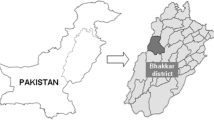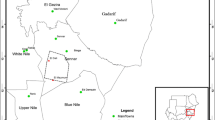Abstract
Increasing trend in the sole crops commercialization has questioned the sustainability of the traditional gum Arabic agroforestry (Bush-fallow) system in western Sudan. This shift in the farming system from a traditional sustainable system to more commercialized one has resulted in a drastic decline in soil fertility, decreased crop productivity and low gum Arabic production. Therefore, identification of alternative options and incentives are required to ameliorate the negative environmental effects of increasing commercialization trends. This paper takes this issue and empirically investigating the factors influencing the decision to adopt agroforestry using a binary probit model. The results show that farmers with less commercialization, access to credit, less fragmented land, more education, high gum Arabic gate price, located away from the markets, and with more years of experience in farming are more likely to practice the traditional gum Arabic agroforestry system. In contrast, the allocation of more working days for commercial sole crops production, more fragmented land, and higher commercialization index reduces the probability of gum Arabic agroforestry adoption. In conclusion, this dichotomy between sole crop commercialization and traditional gum agroforestry system may be solved through the encouragement of the adoption of the traditional intercropping system with gum tree (Acacia senegal). Production of gum tree (Acacia senegal) itself should be more commercialized and prioritized. Conservation programs should focus on more educated, experienced famers with less fragmentized land if the policy is to promote the sustainable farming system in the region to promote soil fertility and to improve the effect of sole crop commercialization on traditional gum Arabic agroforestry system.



Similar content being viewed by others
Notes
It is resin obtained from two species acacia namely Acacia Senegal and Acacia seyal. These two dominant acacia characterizes the gum belt in sub-Sahara Africa. But Acacia Senegal is found in a greater density in Sudan.
The gum of Acacia seyal tree is known as talih.
The NPC is defined as the ratio of the farm gate price to the Free On Boat (F. O. B.) price received in Sudan minus marketing and processing cost.
The term commercialization is defined as the volume of produce and household resources that enter the exchange economy which may include sales or barter of farm products not used for subsistence and off-farm employment of labor and capital (von Braun 1994).
We estimated agricultural Commercialization Index (ACI), which is defined as the value of agricultural product sales divided by total value of crop production (CI = [Gross value of all crop sales of households per year/gross vale of all crop production of households per year] * 100). As the value of the commercialization approaches 100, the famers are likely to be more market oriented.
References
Ballal MEM (2002) Yield trends of gum arabic from Acacia senegal as related to some environmental and managerial factors. Dissertation, University of Khartoum, Khartoum
Barbier EB (2000) The economic linkages between rural poverty and land degradation. Some evidence from Africa. Agric Ecosyst Environ 82:355–370
Brockwell J, Searle SD, Jeavons AC, Waayers M (2005) Nitrogen fixation in acacias: an untapped resource for sustainable plantations, farm forestry and land reclamation. ACIAR Monograph No. 115, 132p
Current D, Lutz E, Scherr S (1995) The cost and benefits of agroforestry to farmers. World Bank Res Obs 10(2):151–180
Diriba G, Sutter P (1994) Rapid food security assessment: North Kordofan State, CARE International in Sudan; CARE. p 108. FSRC No. 5256
Elamin EM, Dirdiri HM, Nassir AE (2000) Pricing policies and agricultural export performance in Sudan: lessons from the 1970s through 1990s. El Obeid Research Station, Sudan
Eldukheri IA (1997) Past changes and future prospects of traditional rain fed farming in North Kordofan. Dissertation, Institut für Wirtschaftsund Sozialwissenschaften der Technischen Universität, München
El-Khidir EE (2003) Economic efficiency of sharecropping in dry lands: a case study of gum Arabic production in Kordofan gum belt, Sudan. Dissertation, University of Putra Malaysia
Feder G, Just RE, Zilberman D (1985) Adoption of agricultural innovations in developing countries: a survey. Econ Dev Cult Change 33:254–297
Ghadim AK, Pannell DJ (1999) A conceptual framework of adoption of an agricultural innovation. Agric Econ 21:145–154
Gibreel TM (2009) Impact of agricultural policy on resource allocation in the gum belt of Sudan: a farm household modelling approach. Dissertation, University of Giessen, Germany
Green WH (1997) Econometric analysis, 3rd edn. Prentice-Hall Inc, Upper Saddle River
GUM Arabic COPMANY (GAC) (2000) Annual report. Gum Arabic Company, Khartoum
Hinton PR (1995) Statistics explained. A guide for social science students. Routledge, London
IFPRI (2006) Empowering the rural poor under volatile policy environments in the Near East and North Africa region: case study Sudan. Final report. http://www.ifad.org/events/nrp/case/sudan.pdf. Accessed 11 June 2007
Iqbal M (1993) International trade in non-wood forest products: an overview. FO: Misc/93/11 Working Paper. Food and Agricultural Organization of the United Nations, Rome
Kananji B (1993) Variation in gum Arabic production of six Sudanese Acacia senegal seed sources. In: Tree seed problems with special reference to Africa. Proceeding of the IUFRO symposium held in Ouagadougou, Burkina Faso, 23–28 Nov 1992: 118–127. http://www.fao.org/docrep/006/v3965e/V3965E14.htm. Accessed 21 July 2006
Lapar MA, Pandey S (1999) Adoption of soil conservation: the case of Philippine upland. Agric Econ 21(2): 241–256. http://dx.doi.org/10.1016/S0169-5150(99)00028-6. Accessed 11 June 2006
Larson BA, Bromley DW (1991) Natural resource prices, export policies, and deforestation: the case of Sudan. World Dev 19(10):128–1297
Ndoye I, Gueye M, Danso SKA, Dreyfus B (1995) Nitrogen fixation in Faidherbia albida, Acacia raddiana, Acacia senegal, and Acacia seyal estimated using the 15N isotope dilution technique. J Plant Nutr Soil Sci 172:175–180
Rahim AH, Ruben R, Van EC (2005) Adoption and abandonment of gum Arabic agroforestry in Sudan. Paper presented at association for temperate agroforestry (AFTA) conference, 2005
Seif El Din AG, Zarroug M (1998) Production and commercialization of gum Arabic in Sudan In: FAO. Domestication and commercialization of nontimber products in agroforestry systems. NonWood Forest Products 9. http://www.fao.org/docrep/w3735e/w3735e00.htm. Accessed 11 March 2005
Sudan and UNFPA (2001). National Safe Motherhood Survey: Sudan, 1999, Khartoum
Taha MN (2000) The socioeconomic role of Acacia senegal in sustainable development of rural areas in the gum belt of the Sudan. Dissertation, Technical University of Dresden, Germany
Trading economics (2012) World bank indicators—Sudan—density and urbanization. http://www.tradingeconomics.com/sudan/population-density-people-per-sq-km-wb-data.html. Accessed 19 March 2006
von Braun J (1994) Introduction. In: von Braun J, Kennedy E (eds) Agricultural commercialization, economic development, and nutrition. Johns Hopkins University Press, Baltimore
Acknowledgments
The authors wish to express their thanks to the local households in the study area, who willingly participated in the survey. The earlier versions of this paper has benefited from the comments and valuable suggestions of the participants of the 2007 IUFRO all Division 5 Conference, Forest Products and Environment-A Productive Symbiosis, October 28th–November 2nd, 2007, Grand Hotel, Taipei, Taiwan. The invaluable comments made by the two anonymous reviewers have contributed to the improvement of this paper. The remaining errors and omissions are our responsibility.
Author information
Authors and Affiliations
Corresponding author
Rights and permissions
About this article
Cite this article
Gibreel, T.M. Crop commercialization and adoption of gum-arabic agroforestry and their effect on farming system in western Sudan. Agroforest Syst 87, 311–318 (2013). https://doi.org/10.1007/s10457-012-9552-2
Received:
Accepted:
Published:
Issue Date:
DOI: https://doi.org/10.1007/s10457-012-9552-2




